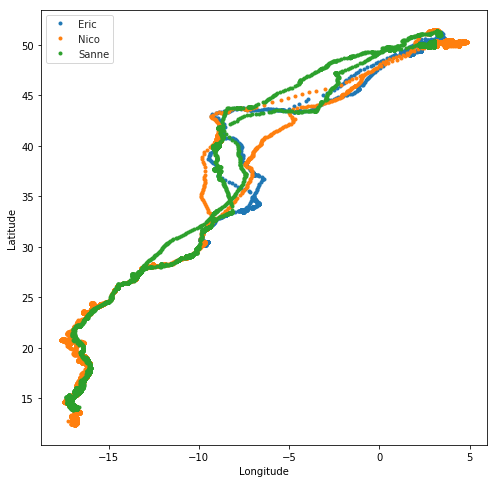Python Tutorial
Python OOPs
Python MySQL
Python MongoDB
Python SQLite
Python Questions
Plotly
Python Tkinter (GUI)
Python Web Blocker
Python MCQ
Related Tutorials
Python Programs
Track Bird MigrationHumans have been fascinated by the fascinating phenomenon of bird migration for centuries. It is truly amazing how well birds can navigate great distances and return to their breeding grounds. This article will examine the complexities of bird migration, tracking techniques, and the significance of studying this natural phenomenon. IntroductionThe regular seasonal movement of birds from one location to another is referred to as bird migration. Resources like food, nesting sites, and favourable weather conditions are what primarily drive it. The migration routes can cover thousands of kilometres and frequently involve navigating terrain obstacles like mountains, deserts, and water bodies. What is migration of birds?Bird migration is a common natural behaviour seen in many different bird species around the world. Birds travel to breeding grounds in the summer and return to their wintering grounds in the winter, which is a cyclical phenomenon that happens every year. Their ability to reproduce and survive depends on this movement. Reasons Birds MigrateThere are many reasons why birds move, including: Food Availability: During the breeding season, when they require a sufficient supply of insects, seeds, and fruits, birds migrate to areas with an abundance of food resources. Breeding: To reproduce and raise their young in areas with hospitable environmental conditions and an abundance of food resources, many bird species migrate to particular regions. Climate: Birds migrate to avoid harsh weather conditions like bitter cold or a lack of food during the winter. Avoiding Competition: Some bird species move to less populated areas to lessen competition for resources. The Science Behind Bird MigrationThe complex interplay of many different factors that affect bird migration includes innate navigational skills, celestial cues, geomagnetic fields, and landmarks. Long-distance flight is made possible by the specialised physiological adaptations that have evolved in birds. These adaptations include improved oxygen transport capabilities, increased fat storage, and effective energy utilisation. Migration patterns of birdsSpecies and geographic location can have a big impact on the patterns of bird migration. While some birds travel only a short distance within their immediate habitats, others make amazing transcontinental migrations. Flyways are significant travel routes that birds use to get from one place to another during migration. Follow-up on Bird Migration Monitoring individual birds' or populations' movements is necessary for studying bird migration. Tracking techniques offer insightful information on migration paths, timing, stopover locations, and behaviour. In the past, researchers tracked birds using a variety of methods, including banding, ringing, and visual observations. Traditional Methods of TrackingBanding/Ringing: This technique involves fastening a tiny metal or plastic band with an individual identification number to a bird's leg. The band can reveal details about the bird's movements and life history if it is captured again or discovered dead. Visual observations: By observing the flight patterns, flock configurations, and stopover locations of birds, scientists and bird enthusiasts can visually track the movement of birds during migration. Technology Advances in Tracking BirdsThe field of tracking birds has undergone a revolution thanks to technological advancements. Modern tracking techniques include the following: Radio MonitoringAttaching tiny radio transmitters to birds allows for radio tracking because the birds' distinctive radio signals can be picked up by specialised receivers. By locating the signals on a regular basis or in real-time, this technique enables researchers to follow the movements of the birds. The transmitters are typically compact and thoughtfully made to reduce any disruption of the bird's natural behaviour. Radio tracking offers useful information on migratory paths, rest stops, and habitat preferences. Satellite MonitoringIn order to track the movements of birds, satellite-based systems are used. The birds are given sophisticated tags with GPS or geolocation technology, enabling precise tracking over great distances. Satellites circling the Earth receive the location information that these tags collect and transmit. Detailed insights into migration patterns, flight paths, and movement timing can be obtained from satellite tracking data. GeolocatorsBirds are equipped with small geolocators that periodically record the amount of light they are exposed to. Based on the times of sunrise and sunset, researchers can infer the bird's location by analysing the recorded data. In order to better understand long-distance migrations, geolocators are particularly helpful because they reveal details about the large-scale movements of birds. Geolocators don't offer real-time tracking, but they do provide useful information for figuring out migration paths and wintering grounds. Radar TechnologyA powerful tool for tracking bird migration on a large scale is radar technology. Bird movement in the atmosphere can be detected by weather radar systems, and it can be followed. Researchers can determine the timing, altitude, and direction of flight as well as patterns and densities of bird migration by analysing the radar data. Radar technology aids in comprehending the dynamics of a bird's overall movement and offers useful data for conservation and aviation safety. Technology for dronesIn recent years, tracking birds with drones has grown in popularity. Drones with thermal imaging and high-resolution cameras can record in-depth aerial footage of bird flocks and their movements. This enables more accurate and non-disturbing research on the behaviour, migration patterns, and nesting habits of birds. Drone technology provides a non-intrusive and creative method for tracking birds that deepens our knowledge of avian ecology. The significance of monitoring bird migration
Code: The bird migration data can be fetched from Online Databases, Scientific Research and Publications, Ornithological Organizations, Bird Banding Programs. For eg:
Output: 
|
 For Videos Join Our Youtube Channel: Join Now
For Videos Join Our Youtube Channel: Join Now
Feedback
- Send your Feedback to [email protected]
Help Others, Please Share










